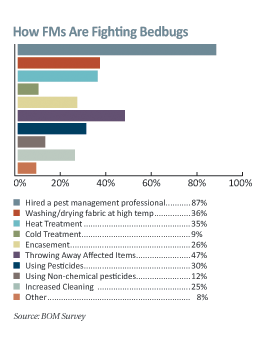What Facility Managers Have Learned About Battling Bed Bugs
The experts agree that the chief weapon against bed bugs is education and having a plan in place. "Staff training and awareness on bed bugs is going to be your first defense," says Gangloff Kaufman. Understanding what they look like and how they travel is important. "There's a lot of misinformation about bed bugs still, even in the media,"she says. She suggests facility managers check out the New York Department of Health's bed bug page at www.nyc.gov/bedbugs for layperson training materials.
Yost recommends having a plan in place ahead of finding a bed bug at your facility, including who will be contacted and what resources are available. Norray agrees.
"The thing is having a policy in place," he says. Especially in high risk areas, have a consultant come in and do an assessment. "And from that consultation, write policy."
Developing a response plan involves deciding how internal and external communications are going to be handled. At Wake Forest, the focus was on keeping everything out in the open. "We didn't want anything to come back that Wake Forest was trying to hide anything," says Yost.
Of course, releasing information to the school's external relations department meant that it was picked up in short order by the local and national media. At the Council for Foreign Relations, the entire population was notified about the first bed bug incident, a practice that was not repeated for the second event. "It became too much water cooler gossip," Norray says.
Whichever way communications are handled, facility managers should take note of the occupants' reaction and keep it from getting it to the point where people are going overboard about bed bugs. Hargraves suggests positioning the facilities department as being informed and on top of the issue. "When information comes to us that we have an issue, we immediately respond," he says. "And we respond visibly." For example, he talks to the teacher in the affected classroom and might put up a carbon dioxide emitter to monitor for additional bed bugs.
Even if a facility has not experienced bed bugs yet, experts say it is likely to happen in the future.
"The (bed bug) population will grow until it gets to the point that people are very well educated and begin to take action," says Wang. "Then we may see the peak. Our society is not quite ready or educated yet. Learn about bed bugs. Don't be panicked, but be prepared."

Click to download PDF
Related Topics:














